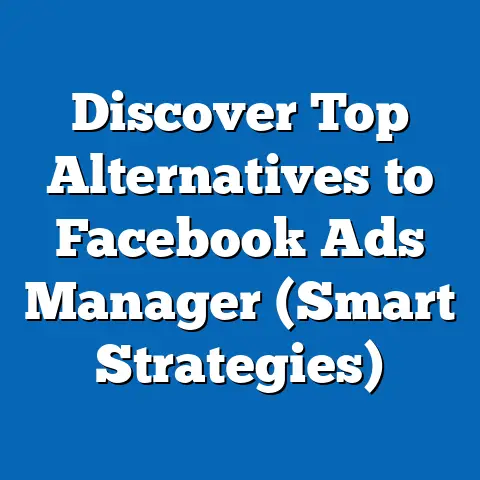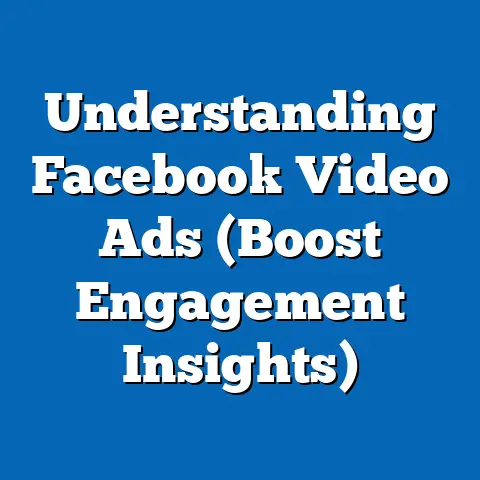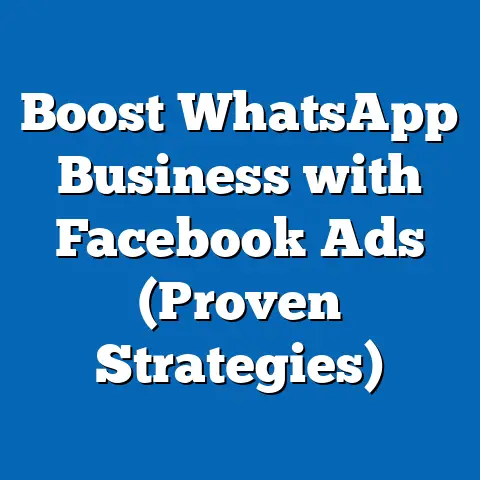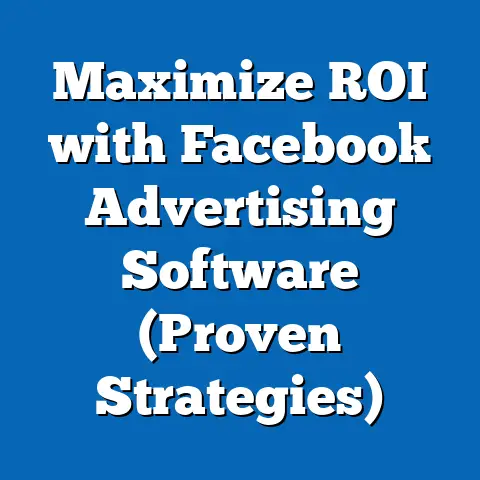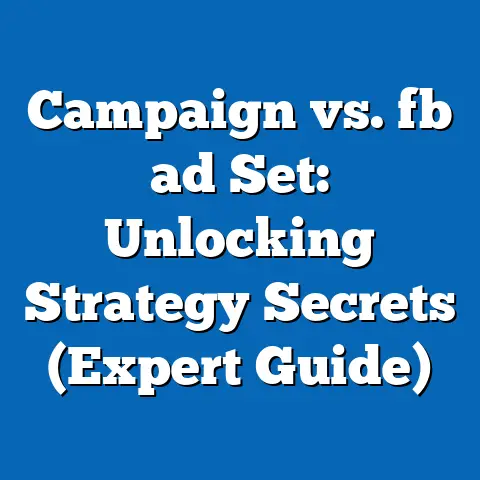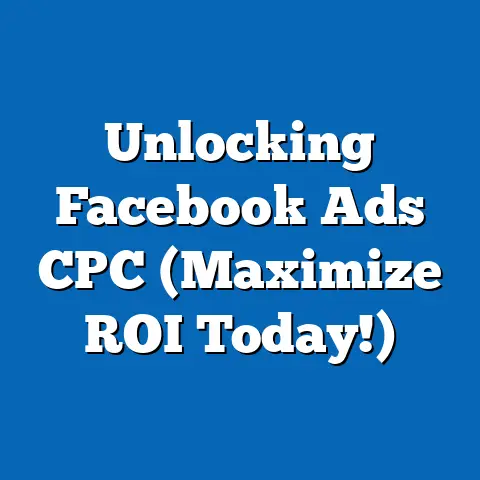Crea Anuncios de Facebook que Conviertan (GuÃa Práctica)
You know you’re in the middle of a serious existential crisis when you find yourself watching cat videos instead of creating your next Facebook ad campaign. I’ve been there! The endless scroll, the dopamine hits from memes…it’s a real struggle. But fear not! While the feline world may have its grasp on our attention, there’s a way to harness that scrolling power to create Facebook ads that convert like crazy! I’m going to walk you through everything you need to know to create Facebook ads that not only capture attention but also turn prospects into loyal customers. Trust me, with the right strategy, you can make your ads as irresistible as those cat videos.
Understanding the Facebook Ecosystem
Facebook. It’s more than just a place to share vacation photos and argue about politics (though there’s plenty of that too!). It’s a powerhouse advertising platform, and you need to understand its landscape to succeed.
Today, Meta reports that over 3 billion people use Facebook every month. That’s roughly half the planet! This massive user base presents an unparalleled opportunity for advertisers. The key, however, is not just reaching everyone, but reaching the right people. That’s where understanding the Facebook ecosystem comes in.
Facebook’s advertising tools are incredibly sophisticated. From detailed demographic targeting to interest-based segmentation, the platform offers a wealth of options to hone in on your ideal customer. I remember when I first started, I was overwhelmed by the sheer number of choices. Should I target by age? Location? Interests? The answer, of course, is: it depends!
The more I experimented, the more I realized that understanding the nuances of these tools is crucial. For instance, you can create custom audiences based on website visitors, email lists, or even people who have interacted with your Facebook page. This level of personalization allows you to deliver highly relevant ads that resonate with your target audience.
Takeaway: Facebook is a massive platform with sophisticated advertising tools. Understanding its user base and the targeting options available is essential for creating effective ads.
Defining Your Goals
Before you even think about crafting ad copy or choosing visuals, you need to answer one fundamental question: What do you want to achieve? Defining your goals is the cornerstone of any successful Facebook ad campaign.
I’ve seen countless campaigns fail because they lacked a clear objective. It’s like setting sail without a destination in mind – you might end up somewhere interesting, but you’re unlikely to reach your desired port.
Your goals should be specific, measurable, achievable, relevant, and time-bound (SMART). Here are some common objectives and how to choose the right one for your business needs:
- Brand Awareness: If you’re a new business or launching a new product, brand awareness might be your primary goal. This objective focuses on reaching a broad audience and increasing recognition of your brand.
- Reach: Similar to brand awareness, the Reach objective aims to maximize the number of people who see your ad. This is useful for promoting events or reaching a local audience.
- Traffic: If your goal is to drive traffic to your website, this is the objective for you. This is great for blog posts, product pages, or any other content you want people to visit.
- Engagement: This objective focuses on generating likes, comments, and shares on your ads. It’s ideal for building a community around your brand and sparking conversations.
- Lead Generation: If you’re looking to collect leads for your business, this is a great option. Facebook offers lead ad formats that allow users to submit their information directly within the platform.
- App Installs: If you have a mobile app, this objective will help you drive downloads.
- Video Views: If you want to increase the number of people who watch your videos, this objective is designed for that purpose.
- Conversions: This objective focuses on driving specific actions on your website, such as purchases, sign-ups, or form submissions. This is the holy grail for many advertisers, as it directly translates to revenue.
- Catalog Sales: If you have an e-commerce store with a product catalog, this objective allows you to showcase your products directly in your ads.
- Store Traffic: If you have a physical store, this objective helps you drive foot traffic to your location.
Choosing the right objective is crucial because it tells Facebook’s algorithm what you want to achieve. The algorithm will then optimize your ads to reach people who are most likely to take the desired action.
Takeaway: Define clear, measurable goals for your Facebook ad campaigns. Choose the objective that aligns with your business needs to maximize your chances of success.
Knowing Your Audience Inside and Out
Okay, so you know your destination (your goals). Now, you need to understand who you’re trying to reach. This is where audience research comes into play. Knowing your audience inside and out is paramount to creating Facebook ads that resonate and convert.
I’ve learned that the more intimately you understand your audience, the more effective your ads will be. It’s not enough to just guess who your target customer is. You need to dig deep and uncover their demographics, interests, behaviors, and pain points.
One of the most valuable tools for audience research is Facebook Audience Insights. This free tool provides a wealth of data about your target audience, including:
- Demographics: Age, gender, education level, relationship status, and job title.
- Interests: Hobbies, passions, and activities that your audience enjoys.
- Behaviors: Purchase history, device usage, and online activities.
- Location: Where your audience lives and travels.
- Page Likes: The Facebook pages that your audience likes.
By analyzing this data, you can gain a deeper understanding of your audience’s needs, preferences, and motivations. This information will inform your ad copy, visuals, and targeting strategy.
For example, let’s say you’re selling organic skincare products. Through Audience Insights, you might discover that your target audience is primarily women aged 25-45 who are interested in health and wellness, natural products, and sustainable living. They also tend to like pages related to yoga, meditation, and organic food.
With this information, you can craft ad copy that speaks directly to their values and interests. You can also use visuals that feature natural ingredients and promote a healthy lifestyle. And, of course, you can target your ads to people who are interested in the pages you identified.
Segmentation is another crucial aspect of audience research. It involves dividing your audience into smaller groups based on shared characteristics. This allows you to tailor your messages to each group, making your ads more relevant and effective.
For instance, you might segment your audience by age, gender, location, or purchase history. If you’re selling multiple products, you might segment your audience based on their interest in specific product categories.
Takeaway: Invest time in audience research using Facebook Audience Insights and other tools. Segment your audience to tailor your messages and create more relevant ads.
Now, let’s talk about what you’re going to say. Ad copy is the heart and soul of your Facebook ads. It’s what grabs people’s attention, conveys your message, and motivates them to take action.I’ve spent countless hours crafting and refining ad copy, and I’ve learned that there’s no magic formula. However, there are some key elements that contribute to effective ad copywriting:
- Attention-Grabbing Headlines: Your headline is the first thing people see, so it needs to be compelling enough to stop them in their tracks. Use strong verbs, intriguing questions, or shocking statistics to pique their interest. For example, instead of “Learn More About Our Product,” try “Discover the Secret to Flawless Skin.”
- Clear and Concise Messaging: Get straight to the point and explain the benefits of your product or service in a clear and concise manner. Avoid jargon and technical terms that your audience might not understand.
- Persuasive Call to Action: Tell people exactly what you want them to do. Use strong action verbs like “Shop Now,” “Sign Up Today,” or “Download Now.” Make your call to action prominent and easy to click.
- Storytelling: People love stories. Use storytelling to connect with your audience on an emotional level and make your ad more memorable. Share customer testimonials, case studies, or personal anecdotes that illustrate the value of your product or service.
- Emotional Triggers: Tap into your audience’s emotions to create a stronger connection. Use words and phrases that evoke feelings of happiness, excitement, fear, or urgency. For example, if you’re selling travel packages, you might use phrases like “Escape to Paradise” or “Unforgettable Adventure.”
Remember, your ad copy should be tailored to your target audience and your campaign objective. What works for one audience might not work for another.
Takeaway: Craft compelling ad copy that grabs attention, conveys your message clearly, and motivates people to take action. Use storytelling and emotional triggers to connect with your audience on a deeper level.
Designing Eye-Catching Visuals
Okay, you’ve got killer ad copy, but let’s be real: on Facebook, visuals are king (or queen!). In a world of endless scrolling, your visuals need to be attention-grabbing and visually appealing to stand out.
I’ve learned that visuals are just as important as ad copy in determining the success of your Facebook ads. In fact, some studies suggest that visuals account for up to 90% of an ad’s effectiveness.
Here are some guidelines for creating visually appealing graphics that align with your brand:
- High-Quality Images: Use high-resolution images that are clear, crisp, and well-lit. Avoid blurry or pixelated images.
- Brand Consistency: Use colors, fonts, and imagery that are consistent with your brand identity. This will help people recognize your brand and build trust.
- Eye-Catching Composition: Use visual elements like lines, shapes, and colors to create a visually appealing composition. Experiment with different layouts and arrangements to see what works best.
- Relevance: Make sure your visuals are relevant to your ad copy and your target audience. Use images that resonate with their interests and values.
- Minimal Text: Avoid overcrowding your visuals with text. Keep it simple and use only the most essential information.
For video ads, here are some best practices to keep in mind:
- Short and Sweet: Keep your videos short and to the point. Aim for a length of 15-30 seconds.
- Captivating Content: Start with a hook that grabs people’s attention within the first few seconds. Use engaging visuals, music, and sound effects to keep them watching.
- Mobile-Friendly: Optimize your videos for mobile viewing. Use vertical or square formats and add captions for people who watch with the sound off.
- Clear Call to Action: End your video with a clear call to action that tells people what you want them to do.
Takeaway: Design eye-catching visuals that are high-quality, brand-consistent, and relevant to your target audience. For video ads, keep them short, captivating, and mobile-friendly.
Leveraging Facebook Ad Formats
Facebook offers a variety of ad formats to suit different objectives and target audiences. Leveraging the right ad format can significantly impact the performance of your campaigns. Let’s explore some of the most popular ad formats:
- Single Image Ads: These are the simplest and most common ad format. They feature a single image or video with accompanying text. Single image ads are great for brand awareness, traffic, and engagement.
- Single Video Ads: These ads feature a single video with accompanying text. Video ads are great for storytelling, product demonstrations, and capturing attention.
- Carousel Ads: These ads allow you to showcase multiple images or videos in a scrolling carousel format. Carousel ads are great for showcasing multiple products, telling a story, or highlighting different features of a single product.
- Collection Ads: These ads feature a hero image or video with a collection of related products below. Collection ads are great for e-commerce businesses looking to showcase their product catalog.
- Instant Experience Ads: These ads are full-screen, mobile-optimized experiences that open instantly when someone clicks on your ad. Instant Experience ads are great for creating immersive brand experiences and driving conversions.
- Lead Ads: These ads allow users to submit their information directly within the Facebook platform. Lead ads are great for collecting leads for your business.
- Messenger Ads: These ads appear in the Facebook Messenger app. Messenger ads are great for engaging with customers directly and providing personalized support.
The best ad format for your campaign will depend on your objective, target audience, and the type of content you’re promoting. Experiment with different formats to see what works best for your business.
Takeaway: Explore the various ad formats available on Facebook and choose the ones that best align with your objectives and target audience. Experiment with different formats to optimize your campaign performance.
Budgeting and Bidding Strategies
Now, let’s talk about the money! Setting a budget and understanding Facebook’s bidding system are crucial for maximizing your return on investment (ROI).
I’ve seen many businesses waste money on Facebook ads because they didn’t have a clear budget or understand how bidding works. It’s like throwing money into a black hole – you might get lucky and see some results, but you’re more likely to end up with nothing to show for it.
Here are some tips on setting a budget:
- Start Small: If you’re new to Facebook advertising, start with a small budget and gradually increase it as you see results.
- Consider Your ROI: Calculate your desired ROI and set a budget that allows you to achieve that goal.
- Use Daily Budgets: Daily budgets allow you to control how much you spend each day. This is a good option if you want to spread your budget out over a longer period of time.
- Use Lifetime Budgets: Lifetime budgets allow you to set a total budget for your campaign. This is a good option if you have a specific budget in mind and want to make sure you don’t exceed it.
Facebook uses an auction-based bidding system to determine which ads are shown to users. Advertisers bid against each other to have their ads displayed to their target audience.
Here are some common bidding strategies:
- Cost-Per-Click (CPC): You pay each time someone clicks on your ad. This is a good option if your goal is to drive traffic to your website.
- Cost-Per-Impression (CPM): You pay for every 1,000 impressions of your ad. This is a good option if your goal is to increase brand awareness.
- Cost-Per-Action (CPA): You pay when someone takes a specific action, such as making a purchase or submitting a form. This is a good option if your goal is to drive conversions.
- Automatic Bidding: Facebook automatically sets your bids to maximize your results within your budget. This is a good option if you’re new to Facebook advertising or don’t want to spend time managing your bids.
The best bidding strategy for your campaign will depend on your objective, target audience, and budget. Experiment with different strategies to see what works best for your business.
Takeaway: Set a budget that aligns with your ROI goals and choose a bidding strategy that maximizes your results. Experiment with different strategies to optimize your ad spend.
A/B Testing for Optimization
A/B testing, also known as split testing, is the process of comparing two versions of an ad to see which one performs better. It’s a powerful tool for optimizing your Facebook ads and improving your ROI.
I’ve learned that A/B testing is essential for continuous improvement. What works today might not work tomorrow, so it’s important to constantly test and refine your ads.
Here’s a step-by-step guide on how to set up and analyze A/B tests on Facebook ads:
- Choose a Variable to Test: Identify a specific element of your ad that you want to test, such as the headline, image, call to action, or targeting.
- Create Two Versions of Your Ad: Create two versions of your ad that are identical except for the variable you’re testing.
- Set Up Your A/B Test: In Facebook Ads Manager, create a new campaign and select the A/B testing option.
- Define Your Budget and Schedule: Set a budget and schedule for your A/B test. Make sure to run the test long enough to gather statistically significant data.
- Analyze Your Results: Once the test is complete, analyze the results to see which version of your ad performed better. Look at metrics like click-through rate, conversion rate, and cost per conversion.
- Implement Your Findings: Use the results of your A/B test to inform your future ad campaigns. Implement the winning version of your ad and continue testing other variables.
Here are some tips for successful A/B testing:
- Test One Variable at a Time: To get accurate results, only test one variable at a time.
- Use a Large Sample Size: The larger your sample size, the more reliable your results will be.
- Run Your Tests Long Enough: Run your tests long enough to gather statistically significant data.
- Document Your Results: Keep track of your A/B testing results so you can learn from your successes and failures.
Takeaway: Use A/B testing to optimize your Facebook ads and improve your ROI. Test different variables, analyze your results, and implement your findings to continuously improve your campaigns.
Monitoring and Analyzing Performance
You’ve launched your ads, you’re A/B testing…now what? Monitoring and analyzing your ad performance is crucial for understanding what’s working and what’s not. It’s like having a GPS for your ad campaigns – it tells you where you are, where you’re going, and how to get there.
I’ve learned that tracking your ad performance is just as important as creating your ads. Without data, you’re flying blind.
Facebook Ads Manager provides a wealth of data about your ad performance, including:
- Impressions: The number of times your ad was displayed.
- Reach: The number of unique people who saw your ad.
- Click-Through Rate (CTR): The percentage of people who clicked on your ad after seeing it.
- Conversion Rate: The percentage of people who took a desired action, such as making a purchase or submitting a form.
- Cost Per Click (CPC): The average cost you paid for each click on your ad.
- Cost Per Conversion (CPC): The average cost you paid for each conversion.
- Engagement: The number of likes, comments, and shares your ad received.
By monitoring these metrics, you can gain valuable insights into the effectiveness of your ads. For example, if your CTR is low, it might indicate that your ad copy or visuals aren’t compelling enough. If your conversion rate is low, it might indicate that your landing page isn’t optimized for conversions.
Based on your performance data, you can adjust your campaigns to improve your results. For example, you might try:
- Refining Your Targeting: Target a different audience or narrow your existing targeting.
- Updating Your Ad Copy: Rewrite your ad copy to make it more compelling and relevant.
- Changing Your Visuals: Use different images or videos that are more eye-catching.
- Adjusting Your Bids: Increase or decrease your bids to optimize your ad spend.
- Testing Different Ad Formats: Try different ad formats to see which ones perform best.
Takeaway: Track your ad performance through Facebook Ads Manager and analyze key metrics to understand what’s working and what’s not. Adjust your campaigns based on performance data to improve your results.
Staying Updated with Facebook’s Policies and Trends
Facebook is constantly evolving. New features are introduced, algorithms change, and advertising policies are updated. Staying informed about these changes is crucial for maintaining compliance and maximizing your ad performance.
I’ve learned that staying ahead of the curve is essential in the world of Facebook advertising. What worked last year might not work this year, so you need to be constantly learning and adapting.
Here are some tips for staying updated with Facebook’s policies and trends:
- Follow the Facebook Business Blog: The Facebook Business Blog is a great resource for staying informed about new features, best practices, and advertising policies.
- Join Facebook Advertising Communities: Join online communities and forums where advertisers share tips, insights, and experiences.
- Attend Industry Events: Attend conferences and webinars to learn from industry experts and network with other advertisers.
- Experiment with New Features: Don’t be afraid to try out new features and ad formats as they are released.
- Read Facebook’s Advertising Policies: Familiarize yourself with Facebook’s advertising policies to avoid getting your ads disapproved or your account suspended.
Here are some common pitfalls to avoid:
- Violating Facebook’s Advertising Policies: Make sure your ads comply with Facebook’s advertising policies regarding prohibited content, targeting, and data collection.
- Using Misleading or Deceptive Claims: Avoid making false or exaggerated claims about your product or service.
- Using Copyrighted Material Without Permission: Don’t use copyrighted images, videos, or music without obtaining the necessary licenses.
- Targeting Sensitive Demographics: Avoid targeting sensitive demographics, such as age, gender, race, or religion, in a discriminatory manner.
Takeaway: Stay informed about Facebook’s advertising policies and trends to maintain compliance and maximize your ad performance. Follow the Facebook Business Blog, join online communities, and attend industry events to stay ahead of the curve.
Conclusion: Call to Action
So, there you have it! A practical guide to creating Facebook ads that convert. I know it can seem overwhelming at first, but with a little practice and persistence, you can master the art of Facebook advertising.
Remember, the world of Facebook advertising is ever-evolving, and staying engaged with the latest strategies will lead to ongoing success. Don’t be afraid to experiment, test new ideas, and learn from your mistakes.
Now, it’s time to put what you’ve learned into practice. Take action today and start creating Facebook ads that not only capture attention but also convert prospects into loyal customers. The possibilities are endless! Get out there and make your ads as irresistible as those cat videos!

